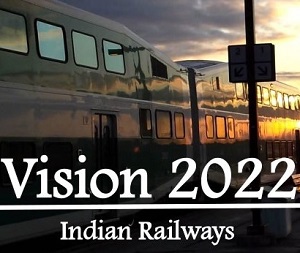Vision 2022 to pull Indian Railways back on track
 Mr. Suresh Prabhu had to resign as Railways Minister due to some unfortunate accidents that marred the end of his tenure. However, even his detractors do not deny the fact that his sincerity and hard work to put the Indian railways on track have been the highlight of his brief tenure as the Railways Minister. Read On ..
Mr. Suresh Prabhu had to resign as Railways Minister due to some unfortunate accidents that marred the end of his tenure. However, even his detractors do not deny the fact that his sincerity and hard work to put the Indian railways on track have been the highlight of his brief tenure as the Railways Minister. Read On ..
Mr. Suresh Prabhu’s ‘Vision 2022 - Reform, Perform, Transform’ document addresses the ‘deeper’ problem in the Indian Railways. Mr. Prabhu has said, "Indian railways was in a vicious circle. We want to change it into virtuous circle. We have been focusing on bringing in investments and improving the financial health of the Indian railways as an efficient service provider."
A beginning has been made with the Dr. Bibek Debroy Committee. It has come out with a number of constructive suggestions to put the Indian railways on stable ground by taking a long-term view of the sector.
The vicious circle begins with the mounting problems caused by a resource crunch. During the last 64 years, while freight loading has gone up 1344%, passenger kms 1642%, route kms has gone up by a measly 23 %.
As much as Rs 1,31,000 crore has been earmarked for the 2017-18 ( plan) , up from Rs 93,795 crore in 2015-16. Around Rs 8,56,020 crore is earmarked for investment in infrastructure including network decongestion through passenger safety and amenities, to station development and logistics parks, etc.
Indian railways is one of the world’s largest railway networks comprising over 1,15,000 km of track and over 7,100 stations. In 2013-14, Indian Railways carried over 23 million passengers every day! Broad gauge lines completed are 2857 kms in 2016-17 and are planned to go up to 3500 kms in 2017-18. Similarly, electrification has gone up from 2013 kms to a planned 4,000 kms in the same period. It is the pace of infrastructure growth that gives some clue to the progress. From 4kms/day in 2014, it has gone up to 9.5kms/day in 2017-18 and is scheduled to rise to 19kms/day by 2022. In view of the critical importance of passenger health, 70,000 bio-toilets will be added in the near future. Their number has gone up from 1917 (average) in 2009-14 to 34,014 in 2016-17.
The growth of tonnage from 1.1 billion tonnes to a projected 2.4 billion tonnes by 2025 depends on whether the Indian Railways grows at the projected 8.5 % (CAGR).
The task is enormous but needs to be carried out. As Dr.Bibek Debroy says,"Indian Railways (IR) is like the Indian cricket team. Everyone has a view and everyone knows how to fix it. Yet, not everyone can play cricket."
Major existing issues
- The railway network is overburdened
- Some regions are beyond the reach of railways due to unfavourable geographical conditions.
- Stiff competition from road transport
- Declining share of passenger and goods traffic
- Overstaffing
- Political pressure groups compel uneconomic projects
- Massive outstanding payments to diesel and electric power supply companies.
- High tariffs of State Electricity Boards and NTPC
- A rise in diesel charges adds to financial burden of the railways, as it is the highest user of diesel.
- Obsolete and old equipment
- Rising deficit resulting from political resistance to increase in fares and tariffs.
Yet the Railways are five times more energy efficient and four times more economical than road transport. So it is churlish to expect the railways that caters to the transport needs of over one billion plus Indians (besides haulage of goods), to become efficient overnight.
In the Eleventh Five Year Plan approach paper in 2006 the focus areas were: capacity augmentation of freight corridors, establishment of logistic parks and terminals, rationalization of freight structures, higher use of IT enabled services, world class quality passenger amenities, public-private partnerships for building and operation of rail infrastructure, design of high capacity wagons ,restructuring of IR to focus on core activities and establishment of a Rail Tariff Regulatory Authority.
The Bibek Debroy Committee has gone beyond these objectives and laid a basis for future policy action by taking a long-term view. It submitted the Report in June 2015. The Report has been prepared in the light of feedback (400,000 word document) from the general public as well as the staff.
The Committee has made the following recommendations:
- Introduction of commercial accounting practices
- Greater decentralisation of powers
- Allowance of entry of the private sector
- Establishment of independent regulator
- Improving accountability
Focus areas/New challenges will be:
- New trains and gauge conversions.
- Mobilisation of Rs 3.5 lakh crores for completion of old and new projects.
- Electrification of 48 per cent of the country’s tracks.
- Ending train delays and improving safety, ensuring fast movement of passengers and freight.
- Bio-toilets installation in the railways.
Total tonnage is set to rise from around 1.1 billion to 2.4 billion by 2025 assuming the Indian Railways grows by 8.5 per cent CAGR. There is little doubt that the railways have to travel a long distance before the operating ratio of 94.9 per cent in 2016-17 is brought down to 80 per cent, considered normal. However, there is no reason why this is not possible given the current enthusiasm and strong political will.
- TradeBriefs Bureau -
Introducing TradeBriefs SME - Print edition - Subscribe Now! | Sample copy